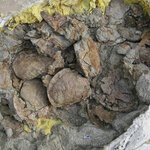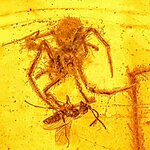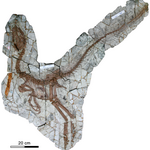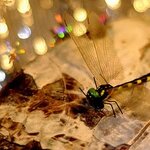Paleontology

An international team of researchers has resolved the evolutionary relationships of Necrolestes patagonensis, the so-called “grave robber” because of its burrowing and underground lifestyle. This much-debated fossil mammal from South America has been a paleontological riddle for 121 years but a recent fossil discovery and comparative anatomical analysis helped researchers to correctly place the strange 16-million-year-old Necrolestes, with its upturned snout and large limbs for digging, in the mammal evolutionary tree.
The new result is an example of the Lazarus effect, in…

Small critters tend to evolve into bigger beasts, according to paleontologist Edward Cope, what is now known as Cope's Rule.
Using statistical modeling methods, a new test of this rule as it applies dinosaurs says that Cope was right -- sometimes. Which is statistically possible.
To see if Cope's rule really applies to dinosaurs, Gene Hunt and Matthew Carrano of the National Museum of Natural History (NMNH) in Washington, D.C., and Richard FitzJohn of the University of British Columbia, used dinosaur thigh bones (femurs) as proxies for animal size. They then used that femur…

A spectacular find of some 1,800 fossilized mesa chelonia turtles from the Jurassic era has been uncovered in China’s northwest province of Xinjiang.
Today one of the world’s driest regions, 160 million years ago Xinjiang was a green place of lakes and rivers, bursting with life. Since 2007, researchers have found fossil sharks, crocodiles, mammals and several dinosaur skeletons.
The turtles had gathered in one of the remaining waterholes during a very dry period, awaiting rain. Today’s turtles in Australia for instance do the same thing. But for the Xinjiang turtles, the rain came…

The coelacanth has one of the longest lineages, 400 million years, of any animal and is the closest living fish to all vertebrates alive on land. Now it has a new member.
Pieces of tiny fossil skull found in Fort Worth have been identified as 100 million-year-old coelacanth bones, according to paleontology graduate student John F. Graf of Southern Methodist University. That places it in the the Cretaceous geologic period, which extended from 146 million years ago to 66 million years ago.
Graf has named the new coelacanth species Reidus hilli and it is now the youngest coelacanth…

Twenty years ago Mary Schweitzer found herself the closest that anyone has ever been to a living dinosaur. As she examined a thin slice of a T. Rex bone fragment under a microscope, she realized she was looking at what appeared to be preserved red blood cells- cells which had no place in a 65 million year old fossil. It was the first time that anyone had found evidence that biological material could survive the passage of millions of years and still retain its molecular structure, challenging one of the central beliefs of paleontologists. Proving that what she was seeing had in fact once…

Researchers have found what they say is the only fossil ever discovered of a spider attacking prey caught in its web – and it dates back 100 million years.
The extraordinarily rare fossils are in a piece of amber that preserved this event in remarkable detail, an action that took place in the Hukawng Valley of Myanmar in the Early Cretaceous between 97-110 million years ago. Aside from showing the first and only fossil evidence of a spider attacking prey in its web, the piece of amber also contains the body of a male spider in the same web. This provides the oldest evidence of social…

Duck-billed dinosaurs, also known as hadrosaurids, had an amazing capacity to chew tough and abrasive plants with grinding teeth more complex than those of cows, horses, and other modern grazers. Hadrosaurids were the dominant plant-eaters in what are now Europe, North America, and Asia during the Late Cretaceous, about 85 million years ago. With broad jaws bearing as many as 1,400 teeth, hadrosaurids were previously thought to have chewing surfaces similar to other reptiles, which have teeth comprised of just two tissues; enamel, a hard hyper-mineralized material, and orthodentine, a…

A set of fossil footprints in Joggins, Nova Scotia have been identified as the world’s smallest - among vertebrates to-date, anyway.
The footprints were found at Joggins Fossil Cliffs. A fossil specimen of the ichnogenus Batrachichnus salamandroides was collected by local amateur paleontologist Gloria Melanson, daughter of Don Reid, the famed Keeper of the Joggins Cliffs, while walking the Joggins beach. Joggins Fossil Cliffs is a UNESCO World Heritage Site.
The footprints belonged to a small amphibian which would have roamed the Earth 315 million years ago, a creature not unlike a…

Analysis of the abdominal contents of two dinosaur fossil specimens reveals new information about their hunting and eating behavior, according to a new report. They may have been stealth hunters.
The authors investigated the abdominal contents of two specimens of Sinocalliopteryx gigas, a small carnivorous dinosaur from China.
One specimen appeared to have eaten a bird-like dinosaur, a dromaeosaurid leg, and the other's abdominal cavity contained the remains of at least two primitive birds, Confuciusornis sanctus, in addition to bones from a possible ornithischian.
The researchers…

Dragonflies, from the order Odonata, have been around for over 250 million years. The most conspicuous difference in their evolution over time is the steady shrinking of their wingspan from well over two and a half feet down to a few inches. Voracious predators, today they dine on bees, wasps, butterflies and avoid the attentions of birds and wee lizards -- but back in the day, they had a much larger selection of meals within their grasp. Small lizards and birds who today choose dragonflies as a tasty snack used to be their preferred prey.